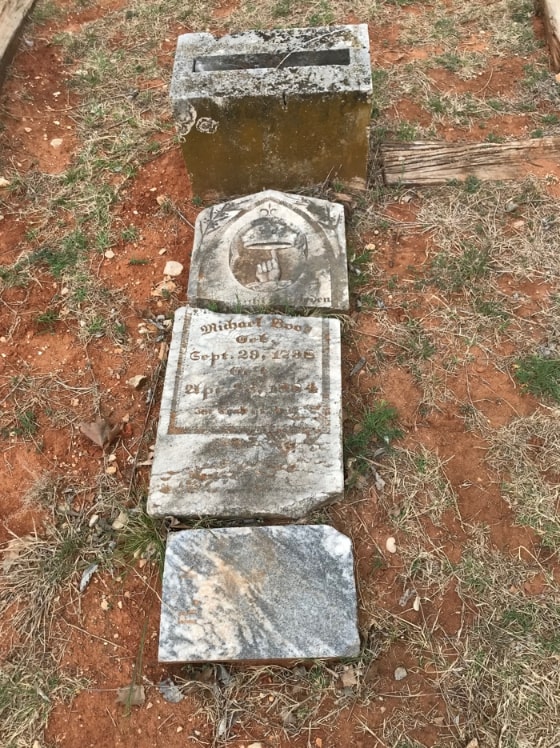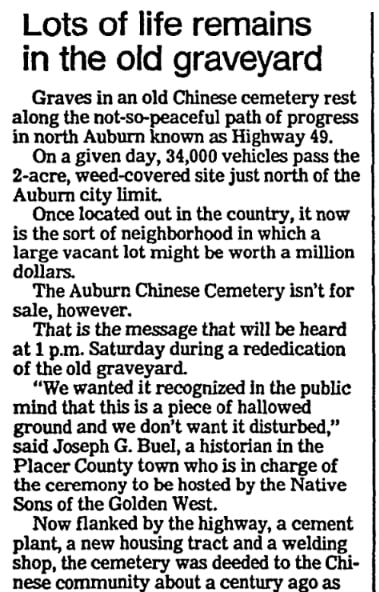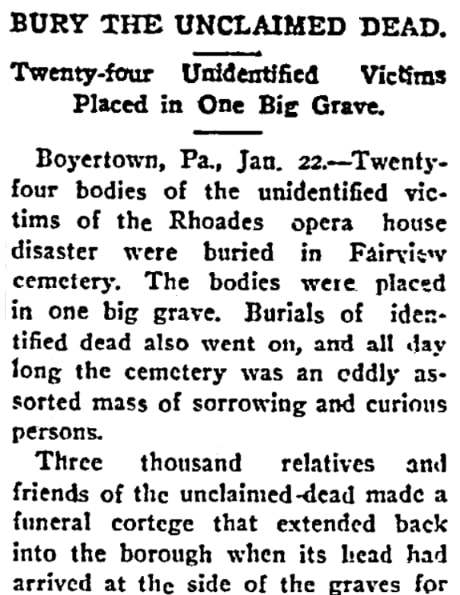Introduction: In this article, Gena Philibert-Ortega gives search tips and possible reasons for why you can’t find your ancestor’s grave. Gena is a genealogist and author of the book “From the Family Kitchen.”
When we start researching an ancestor, we start with the end. In genealogy, we start with the latest event and work backward in time. The latest event, death, we assume should be in a local cemetery in a marked grave, leaving behind records including obituaries and death certificates. But in the case of the cemetery and grave marker, it’s possible that nothing may be found. There are various reasons why you may not find an ancestor’s grave. The following three are just a few reasons to consider as you research.

#1: Not All Cemeteries Include Everyone
One resource you may consult when searching for an ancestor’s burial is a transcription or index of the local cemetery, either online or in print. When the ancestor’s name doesn’t appear in a burial list you might assume they were buried far away from home, not in the local cemetery. That’s a possibility but it’s also important to keep in mind the history of that cemetery and the types of cemeteries in that area.
Some cemeteries are for specific groups. For example, a National Cemetery is for veterans and their dependents, spouses and underage children. There could be an exception to this rule, such as one I went to that started out as a family cemetery before it evolved to be a military cemetery, but in general you will only find veterans and their dependent family members in military cemeteries.
Historically cemeteries were exclusionary and segregated. Cemeteries reflect what was happening in the “living” world at the time. Ethnic and racial groups were not always buried with whites, for example. If they were buried in the same cemetery, they may have been placed in a segregated area of the cemetery. That’s why there can be several cemeteries in an area, some that were specifically for racial or ethnic groups such as African Americans or the Chinese.
Here’s an article about the century-old Auburn Chinese Cemetery.

Because history matters, make sure to research what cemeteries existed in that area during the time of your ancestor’s death. Local histories and historical newspaper articles can help with that.
#2: Not Everyone Is Buried
There are circumstances where someone is not buried. A more present-day example is those who are cremated and their ashes scattered in a forest or ocean. There may be no extant records documenting this. It might just be something the family knows or remembers.
Cremation is not just a recent phenomenon. The first cremation in the United States was in 1876. By 1887, Lancaster, Pennsylvania; Cincinnati, Ohio; Los Angeles, California; Buffalo, New York; and Detroit, Michigan, had crematories. You can read more about this history in my GenealogyBank Blog article on the topic: Was Your Ancestor Buried? A Short History of Cremation.
Other than cremation, a person may not be buried due to the circumstances of their death. For example, when I was researching my book Cemeteries of the Eastern Sierra, I came across a newspaper article about a German immigrant couple, Conrad and Anna Rettenbacher, who settled in California in the 1930s.
They went missing while on a hike in the Mammoth Lake area in August 1934 with their hiking club. During the rescue effort their bodies were found 600 feet down a mountain. Because of the dangerous conditions, the decision was made to bury their bodies where they were found.*
The Rettenbacher’s situation is an example of what happens with those whose deaths make the body unretrievable, including hiking, swimming, military battles (such as the sinking of a ship in the ocean), and other similar incidents. Knowing the circumstances around an ancestor’s death can make it easier to determine where and if they were buried in a traditional cemetery.
#3: Not Everyone Has a Grave Marker (or One That Is Readable)
Finally, let’s consider why not everyone has a grave marker. While we expect to find our ancestors buried in a cemetery with a readable grave marker, this is not always the case. There are a few reasons for this, including:
- The family had no money for a marker.
- The marker was stolen.
- The marker has become illegible over time.
- The marker is broken or destroyed.
- The grave was marked with a temporary funeral home marker that has since disappeared.
- The person’s name was unknown at the time of their death.
- The person was unclaimed and buried with others who were impoverished or unclaimed in a mass grave.
- The person was institutionalized and buried with a number and not a name. Or they were buried without a marker.
Judging from this list you can see there are many reasons why someone may not have a readable grave marker, or a grave marker at all.
Over time, even marked graves can be illegible, stolen, or destroyed. If the cemetery is abandoned, then the details of their burial may be lost altogether.

If the person or their family was impoverished, they may not have a grave marker. They may have been buried in a potter’s field with little to no identification. If they died in an area where no one knew their identify, they may have been buried with others who were unclaimed in a mass grave. Once again, considering the situation around the person’s death and the histories of the local cemeteries can help.
Not Everyone Can Find Their Ancestor’s Grave
It’s just a fact of research. Not all ancestor’s final resting places can be found. Efforts to find them should include death certificates (depending on time and place), articles in historical newspapers, and local histories. Even with exhaustive research, you may not be able to find a place to visit and document the deceased ancestor. Make sure to record what you do know about the death and the possible reasons why they are without a grave or a marked grave.
* Philibert-Ortega, Gena. “Cemeteries of the Eastern Sierra. Arcadia,” 2007, p. 87.
Explore over 330 years of newspapers and historical records in GenealogyBank. Discover your family story! Start a 7-Day Free Trial
Note on the header image: Common Burying Ground and Island Cemetery in Newport, Rhode Island. Credit: Matt H. Wade; Wikimedia Commons.
Related Articles:
- It’s Not All Online: Cemetery Research
- Genealogy Tips: Lessons Learned from Writing a Cemetery Book
- Genealogy Tip: What Does a Gravestone Tell Us?
- Genealogy Tip: What a Gravestone Tells Us – Grave Markers
- Genealogy Tip: How Accurate Is That Gravestone?
- Cemetery Language: A Glossary for Genealogists
- Genealogy Tip: White Bronze Markers at Cemeteries
- Genealogy Tip: Gravestone Porcelain Photos
- Cemetery Etiquette for Genealogists

Or the deer knocked down the tombstone and it is now likely stacked with other stones around a tree. I couldn’t find a tombstone that I had previously seen in an Indiana cemetery. That’s when I discovered the pile of stones and observed the deer in the cemetery. Fortunately it is documented in a book.
Thanks for that example Marcia! That’s why it can be helpful to check previous transcriptions of the cemetery or older photo collections. What isn’t here today because of damage, etc., may have been there when someone else visited.
Another possibility, at least in 18th and maybe early 19th Century New England (and probably elsewhere) is that the person was buried in the back yard — or at least, on the farm that the family owned. The marker may have been such that it did not last, and the gravesite is lost to history. Back-yard burials may have been done for financial reasons (they didn’t cost anything) or sentimental ones (“mom and dad should stay on the land they worked for 50 years”).
Thanks, Jack, for another great example of why you may not find a burial. My 19th-century Texas ancestor was buried on the family farm, and that burial is now “lost.”
I and my children spent much time visiting cemeteries, esp. in the Michigan UP and Canada. I’ve learned many tricks in the 55+ years I’ve worked with genealogy. One stands out however. My 1x Great Grandfather John Carleton Moore was a well-known mason in the UP and left a trail of impressive work on Mackinac Island and the mainland (St.Ignace). I spent 3 years searching for where he was laid to rest. Hints abounded and the only one that caught my interest was from a cousin who knew it was in Lakeside Cemetery along some trees. I went for a “long shot” since it was all I had. I took my son, a shovel and a couple steel rods. We worked along all the tree lines, penetrating the ground in a search for some pattern of buried stone or hopefully something. After several hours, I hit something peculiar with a definite rectangular form between the woods and sidewalk. I dug around the pattern finding it about 6-inches beneath the turf. I dug on the sidewalk end and behold – opened about a 12-inch hole – cleaned the old dirt and there it was – Grandpa’s name in the poured cement curbing under the turf. It was never maintained by anyone and as the turf rose over 100+ years (1901) the name and curbing disappeared, caretakers tossed leaves and twigs from cleanups onto the turf along the bushes adding debris to the matter. I dug up the turf trying to separate the name and curb to no avail – water and more dirt simply filled my hole. I contacted a local grave marker man and had him install a normal full footing with a traditional marker adding a “trowel” (he was a mason) to the marker with full name, dates I had researched carefully of DOB and DOD, and put it on my Facebook page notifying relatives who are now scattered around the country. I got many responses – many had been searching for his gravesite as well and were pleased. Finding and updating such family burial sites is a handshake to those who came before us. I enjoy visiting their graves and doing what I can to maintain and repair them.
Thank you for providing this example, Martin. Grave markers do “disappear” over time under grass and other organic materials. I’ve seen many that are almost completely obscured by grass.
Just a side note, unless the cemetery or land is abandoned, make sure to get the permission of the cemetery or the land owner when digging. That is against the rules in some places.
According to stories told by his grandchildren, my great great grandfather physically abused his wife so much that when she eventually died, he buried her himself in an unmarked grave on his homestead property. This was sometime in the 1800s before law & order and rules & regulations circumscribed such events. I have searched for the grave, but a century and many decades have erased any trace thereof.
James, abuse is about power and control, and so having control over a person’s final resting place would be par for the course.
You might want to look into what cemeteries did exist during that time. It’s also possible she was buried elsewhere without a marker, and without records, it would make it impossible to find.
Thank you for sharing this example.
Having spent a number of years looking for 19th century ancestor graves, as well as 19th century graves of non-ancestor pioneers in two small, long-abandoned cemeteries in the Midwest, I’ll offer a few more reasons that you may not be able to find your ancestor’s grave. (1) I’ve found that graves of elderly persons, especially men, that never married or that outlived their spouse, children, and/or siblings, are more likely than others to be buried in unmarked graves. Lacking survivors, the placement of a grave marker could have been indefinitely (and ultimately, forever) delayed or never considered. Of course, those having had no children are direct ancestors to no one and thus are less often the focus of genealogy. (2) Persons whose remains were returned to a cemetery that was hundreds of miles away are good candidates for unmarked burials. (3) Graves of persons buried on farmsteads or other private property, a practice at least somewhat common in the Midwest during the 19th and early 20th centuries, can be especially difficult to locate. Even when combined with diligent on-the-ground investigation, the ever-increasing amount of online genealogical information is no guarantee that an ancestor resting in an unmarked grave will be found.
Thank you, John. I appreciate these examples.
May be buried on the family land, not in cemetery — or cemetery may be long lost.
Thanks, Mary! Definitely a few of the reasons why it can be impossible to find a burial.
There is another reason why you might be unable to find a grave. My father’s sister, age 4, died of diphtheria in 1911 (records found in City Hall). She was buried in the children’s section of a parish-owned Catholic cemetery in Massachusetts. Over the years we visited her grave when we would go to our grandparents’ graves. I took a photo of the little headstone in the ’70s. Having moved far from the area, I was unaware that the cemetery was facing financial challenges and was taken over by the local diocese. Last year when I returned and went to the children’s section, it looked entirely different. So I went to the office and asked the receptionist about the location of the grave and described the children’s section. She consulted the records and told me she found nothing and that the cemetery never had a children’s section. I explained what I knew and that’s when I learned that the diocese had taken over. It was clear to me that all of the graves in that section and records of them had been obliterated so that new graves could be installed. I don’t know where all the little headstones, bought with the money of grieving immigrants, were taken. The fact that these burial sites and any records of them have vanished seems disrespectful and disgraceful to me.
I’m so sorry to hear you’ve experienced this, Gabrielle. I have heard of similar stories of cemeteries being repurposed or burials being reused by unethical management. Does your family have any of the documents from the burial that would show the payment of the plot and its location?
Thank you for sharing this.
I am 85 years old and recently my wife passed away. She is buried at Jefferson Barracks National Cemetery in St. Louis County, Missouri. My son and I have thoroughly documented her gravesite/gravestone therein.
I wish my ancestors had been more thoughtful of the future interest in this subject. I do know that financial circumstances and local religious, political and racial biases can also cause problems in searches for gravestones, etc.
In Mississippi especially, graveyards can be and are side by side in many instances and even commingled in some cases. Mississippi newspapers and death certificates can be misleading as well. Newspapers contain “death notices,” “obituaries” and other various names for death information. They may not be available for research except by paid subscription to the newspaper.
I have physically found ancestral graves, but other than documenting the location by contact with still living survivors (relatives and friends) I cannot get documentation.
I am so sorry for your loss, Elbert. Thank you for taking the time to write about what you have done to ensure her burial place is well documented. It’s a good idea for more of us to consider as our more recent loved ones pass.
This is an interesting read! I think it’s something necessary for all to read, so that people will know what happened to their dearly departed relative’s remains. I’m glad someone came up with a solution. Because I have heard from my mother that we might have a relative in a Potter’s Field.
Thank you Miz Char. I appreciate you taking the time to read and comment.
A third great grandfather of mine was buried on his farm. Two generations later, the farm had passed out of the family and his headstone was found, flat on the ground, being used as a stepping stone into a pigsty. If this had not been recorded by an astonished onlooker, we would never know.
Ann, you bring up two good points. One is that when the family farm is sold, that burial becomes “lost.” Second, that marker may not be important to the new owners and could be repurposed—in your example, as a stepping stone for the pigsty, but there are others.
Thank you for taking the time to comment.